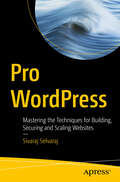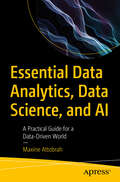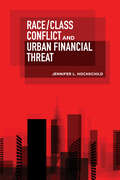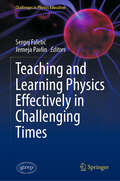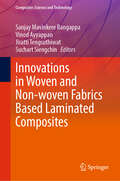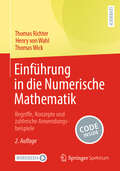- Table View
- List View
Pay and Working Conditions in the Long-Distance Truck and Bus Industries: Assessing for Effects on Driver Safety and Retention
by Committee on National Statistics Division of Behavioral and Social Sciences and Education Transportation Research Board National Academies of Sciences, Engineering, and Medicine Consensus and Advisory Studies Committee for a Study of the Impacts of Alternative Compensation Methods on Truck Driver Retention and Safety PerformanceFor-hire trucking—as opposed to in-house private carriers that transport the goods of their parent company—is a large and heterogeneous industry with considerable variability in carrier sizes, operational structures, and freight markets served. For this sector, the Federal Motor Carrier Safety Administration should explore opportunities for leveraging research and data collection that may be planned and programmed for other purposes to help regulators, researchers, and industry examine the potential effects of driver compensation and work conditions on the safe driving behavior and performance of long-distance for-hire truck drivers. This is among the recommendations in TRB Special Report 355: Pay and Work Conditions in the Long-Distance Truck and Bus Industries: Assessing for Effects on Driver Safety and Retention, from the Transportation Research Board of the National Academies of Sciences, Engineering, and Medicine. The report examines—in response to a request from the U.S. Congress—the impacts of various methods of driver compensation on safety and driver retention, including hourly pay, payment for detention time, and other payment methods used in the industry.
Parks and Other Recreational Uses on Airport Property
by Transportation Research Board National Academies of Sciences, Engineering, and Medicine Airport Cooperative Research Program C. Daniel PratherAirports that have publicly accessible parks or other recreational use spaces on airport property have reported strengthening community relationships. ACRP Synthesis 137: Parks and Other Recreational Uses on Airport Property, from TRB's Airport Cooperative Research Program, describes the experiences of airports that provide airport property for publicly accessible parks and other recreational uses. This effort includes documenting the development, management, and operation of existing airport programs; the perceived benefits and risks of utilizing airport property for parks and recreational uses; and how these uses can support community goals.
A Plan to Promote Defense Research at Minority-Serving Institutions
by Policy and Global Affairs Board on Higher Education and Workforce National Academies of Sciences, Engineering, and Medicine Committee on the Development of a Plan to Promote Defense Research at Historically Black Colleges and Universities, Tribal Colleges and Universities, Hispanic-Serving Institutions, and Other Minority-Serving Institutions André N. Porter Erin Lynch Andrea ChristelleEngaging the full breadth of talent in the United States is an important component of growing and sustaining dominance in research and development (R&D) and supporting national security into the future. By 2030, one-fifth of Americans will be above age 65 and at or nearing retirement from the workforce. Estimates of race and ethnic demographic changes between 2016 and 2030 show a decrease in the non-Hispanic white population and an increase in terms of both number and share of all other demographic groups, and this trend will continue to increase. These population shifts signal a citizenry and workforce that will be increasingly diverse. For the United States to maintain its global competitiveness and protect its security interests, targeted support is needed to cultivate talent from communities throughout the nation. The nation's more than 800 Minority-Serving Institutions (MSIs) provide an impactful and cost-effective opportunity to focus on cultivating the current and future U.S. population for careers in science, technology, engineering, and mathematics (STEM), including in fields critical to the U.S. Department of Defense (DOD). At the request of DOD, this report identifies tangible frameworks for increasing the participation of MSIs in defense-related research and development and identifies the necessary mechanisms for elevating minority serving institutions to R1 status (doctoral universities with very high research activity) on the Carnegie Classifications of Institutions of Higher Education scale.
NASA at a Crossroads: Maintaining Workforce, Infrastructure, and Technology Preeminence in the Coming Decades
by Space Studies Board Division on Engineering and Physical Sciences Aeronautics and Space Engineering Board National Academies of Sciences, Engineering, and Medicine Committee on NASA Mission Critical Workforce, Infrastructure, and TechnologySince its formation more than 60 years ago, the National Aeronautics and Space Administration (NASA) has served as a global leader in science, aeronautics, and exploration, propelled technological innovation, and inspired youth to pursue careers in science and engineering, while often accomplishing the seemingly impossible. However, despite its critical and transformative role, NASA faces an uncertain future due to declining national investment as a percentage of gross domestic product and systemic issues that compromise its infrastructure, workforce, and capacity for technological innovation. As requested by Congress in the CHIPS and Science Act of 2022, the National Academies of Sciences, Engineering, and Medicine convened an independent expert committee to evaluate whether NASA’s current workforce, infrastructure, technological capabilities, and their interfaces can meet its strategic goals. NASA at a Crossroads: Maintaining Workforce, Infrastructure, and Technology Preeminence in the Coming Decades considers the critical facilities and emerging technologies necessary to fulfill NASA’s mission, as well as the workforce skills and organizational structure required to perform and support the work of the mission directorates, both now and in the future.
The State of the U.S. Biomedical and Health Research Enterprise: Strategies for Achieving a Healthier America
by The Learning Health System Series National Academy of Medicine Shannon Takala-Harrison Audrey M. HuangThe U.S. biomedical research enterprise has played a vital role in advancing science, human health, and the economy. It has contributed significantly to fields such as agriculture, environmental remediation, job creation, and technological innovation. Over the past 80 years, landmark achievements include reducing cancer mortality, developing HIV/AIDS treatments, sequencing the human genome, and creating vaccines that mitigated the impact of the COVID-19 pandemic. The enterprise has grown remarkably in less than a century and holds even greater potential for future success. However, its progress is hindered by a lack of high-level national coordination, a fragmented funding system, and a declining workforce. The State of the U.S. Biomedical and Health Research Enterprise: Strategies for Achieving a Healthier America addresses these challenges in five key areas–strategic vision, funding, health equity, coordination and convergence science, and workforce development–offering a roadmap that could be used to sustain U.S. leadership in global health.
Implementing Data Governance at Transportation Agencies: Volume 2: Communications Guide
by Transportation Research Board National Academies of Sciences, Engineering, and Medicine National Cooperative Highway Research Program Llc Anything Awesome Vanasse Hangen Brustlin, Inc. Spy Pond Partners, LLCData governance involves changing the mindset and behaviors of data managers, producers, and users across the organization. Therefore, communication is key to success of any data governance initiative. NCHRP Web-Only Document 419: Implementing Data Governance at Transportation Agencies, Volume 2: Communications Guide, from TRB’s National Cooperative Highway Research Program, is a companion document to NCHRP Web-Only Document 419: Implementing Data Governance at Transportation Agencies, Volume 1: Implementation Guide.
Global Pathways to Net-Zero: Behavioral, Social, and Technological Research and Innovation Strategies for Transportation Decarbonization; Summary of the Seventh EU-U.S. Transportation Research Symposium: Proceedings of a Symposium
by Transportation Research Board National Academies of Sciences, Engineering, and Medicine Consensus and Advisory Studies DivisionThe climate crisis poses a threat to life on the planet, with human health, ecosystem, and economic impacts globally. These impacts are projected to worsen in the future, as greenhouse gas emissions continue to rise and warming to date continues to produce adverse effects. For example, in 2022 alone, the United States experienced 18 separate billion-dollar weather and climate disasters, totaling $165.1 billion. With the transportation sector being a leading source of emissions, it is essential that immediate steps are taken to decarbonize transportation and to continue to invest in the research needed for our decarbonization commitments to be met. Global Pathways to Net-Zero: Behavioral, Social, and Technological Research and Innovation Strategies for Transportation Decarbonization: Summary of the Seventh EU-U.S. Transportation Research Symposium: Proceedings of a Symposium, from the Transportation Research Board, summarizes a symposium held June 11–12, 2024, in Washington, DC. It was hosted by the U.S. Department of Transportation, the European Commission, and TRB.
Nuclear Terrorism: Assessment of U.S. Strategies to Prevent, Counter, and Respond to Weapons of Mass Destruction
by Division on Earth and Life Studies Nuclear and Radiation Studies Board National Academies of Sciences, Engineering, and Medicine Committee on Assessing and Improving Strategies for Preventing, Countering, and Responding to Weapons of Mass Destruction Terrorism: Nuclear ThreatsFor nearly eight decades, the world has been navigating the dangers of the nuclear age. Despite Cold War tensions and the rise of global terrorism, nuclear weapons have not been used in conflict since Hiroshima and Nagasaki in 1945. Efforts such as strategic deterrence, arms control and non-proliferation agreements, and the U.S.-led global counterterrorism have helped to keep nuclear incidents at bay. However, the nation’s success to date in countering nuclear terrorism does not come with a guarantee, success often carries the risk that other challenges will siphon away attention and resources and can lead to the perception that the threat no longer exists. This report found that U.S. efforts to counter nuclear or radiological terrorism are not keeping pace with the evolving threat landscape. The U.S. government should maintain a strategic focus and effort on combatting terrorism across the national security community in coordination with international partners, State, Local, Tribal and Territorial authorities, the National Laboratories, universities and colleges, and civil society. Developing and sustaining adequate nuclear incident response and recovery capabilities at the local and state levels will likely require significant new investments in resources and empowerment of local response from Federal Emergency Management Agency (FEMA), working with the Centers for Disease Control and Prevention, Environmental Protection Agency, Department of Energy, and National Institutes of Health.
Developing a Strategy to Evaluate the National Climate Assessment
by Committee on National Statistics Division of Behavioral and Social Sciences and Education Board on Environmental Change and Society Division on Earth and Life Studies Board on Atmospheric Sciences and Climate National Academies of Sciences, Engineering, and Medicine Committee to Develop a Strategy to Evaluate the National Climate AssessmentThe National Climate Assessment (NCA) is a report produced periodically by the United States Global Change Research Program that takes a comprehensive look at global climate change. Before release, it undergoes intensive review for technical accuracy. What has not been studied in-depth are the users and uses of the NCA, and how the report has informed decision-making. To support evaluation of stakeholder use of the NCA, the National Academies prepared a strategy for creating and implementing an evaluation design that can inform ongoing and future NCAs and related products. This can support a process of continuous improvement. The NCA serves a large number of audiences, and they vary in their needs and in access to climate information. An evaluation would benefit from understanding how the audiences for the NCA are interconnected through networks and how they use, modify, and transmit information from the report. The evaluation would also benefit by first creating a logic model to describe how the NCA is hypothesized to achieve its intended outcomes. The logic model can then be used to design a set of overarching evaluation questions, and to prioritize which audiences to target in the evaluation. Different research methods will be appropriate depending on the audience and the level of information available about the audience. Such an evaluation, taken in stages, can reveal the impact of federal climate science on decisions across the nation and help the USGCRP address any gaps and frailties in the NCA and related products and how they are communicated in the future.
Implementing Data Governance at Transportation Agencies: Volume 1: Implementation Guide
by Transportation Research Board National Academies of Sciences, Engineering, and Medicine National Cooperative Highway Research Program Llc Anything Awesome Vanasse Hangen Brustlin, Inc. Spy Pond Partners, LLCAs of 2023, two-thirds of the 51 state departments of transportation (DOTs) had established some form of agency-level data governance or were actively exploring setting up data governance in their agencies.; NCHRP Web-Only Document 419: Implementing Data Governance at Transportation Agencies, Volume 1: Implementation Guide, from TRB’s National Cooperative Highway Research Program, draws upon lessons learned and successful practices of these early adopters.
Optimizing Recruitment and Admissions Strategies in Health Professions Education: Proceedings of a Workshop
by Board on Global Health Global Forum on Innovation in Health Professional Education National Academies of Sciences, Engineering, and Medicine Health and Medicine DivisionThe National Academies Global Forum on Innovation in Health Professional Education hosted a hybrid public workshop in March 2024 to consider the use of admissions strategies for ensuring a sustainable, high-quality workforce that is adequately staffed, reflects the population being served, and is equitably distributed. Speakers explored the evidence supporting present and potential admissions processes and which metrics best track students’ professional outcomes after admissions.
Methods for Assigning Short-Duration Traffic Volume Counts to Adjustment Factor Groups to Estimate AADT
by Paul Anderson Transportation Research Board National Academies of Sciences, Engineering, and Medicine Anik Das National Cooperative Highway Research Program Shawn Turner Elizabeth Stolz Ben Chen Mark Hallenbeck Zihang Wei Ioannis TsapakisAnnual average daily traffic (AADT), which represents traffic on a typical day of the year, is used by transportation agencies for reporting requirements, allocating resources, informing decision-making, and supporting various agency functions. NCHRP Web-Only Document 406: Methods for Assigning Short-Duration Traffic Volume Counts to Adjustment Factor Groups to Estimate AADT, from TRB’s National Cooperative Highway Research Program, is a supplement to NCHRP Research Report 1124: Guide on Methods for Assigning Counts to Adjustment Factor Groups
Engineering the Future for Sustainability: Measuring and Communicating Our Progress: Proceedings of a Forum
by National Academy of EngineeringThe theme of the 2023 annual meeting of the National Academy of Engineering, which was held in Washington, DC, on October 1-2, was "Engineering the Future for Sustainability." A highlight of the meeting was a plenary presentation entitled "Sustainability: The Defining Challenge and Opportunity of the 21st Century", which explored the vital contributions of engineers in the movement toward sustainability. This publication summarizes the presentation and discussion of the plenary.
Failure Analysis of the Arecibo Observatory 305-Meter Telescope Collapse
by Division on Engineering and Physical Sciences Board on Infrastructure and the Constructed Environment National Academies of Sciences, Engineering, and Medicine Committee on Analysis of Causes of Failure and Collapse of the 305-Meter Telescope at the Arecibo ObservatoryBuilding and operating cutting-edge, custom-designed research facilities presents unique challenges, where prior designs and experience may not be a reliable guide and unprecedented modes of failure can never be fully anticipated. In 2020, the National Science Foundation’s telescope at the Arecibo Observatory in Puerto Rico collapsed, impacting the work of the National Astronomy and Ionosphere Center. Failure Analysis of the Arecibo Observatory 305-Meter Telescope Collapse analyzes the causes of the collapse through extensive review of prior forensic investigations, information gathering from employees at Arecibo Observatory, study of relevant research, consultations with other experts, and examination of structural analyses, engineering plans, inspection reports, photographs, and repair proposals. This report presents lessons learned and makes recommendations to help ensure the safe operation of other unique, critical science facilities.
Strategies to Enable Assured Access to Semiconductors for the Department of Defense
by Division on Engineering and Physical Sciences Policy and Global Affairs National Materials and Manufacturing Board Board on Science, Technology, and Economic Policy National Academies of Sciences, Engineering, and Medicine Committee on Global Microelectronics: Models for the Department of Defense in Semiconductor Public-Private PartnershipsSemiconductor chips power practically all electronic devices, from cellphones and vehicles to communications and defense systems essential for national security. The Department of Defense (DoD) uses a wide range of semiconductors for mission systems such as radars, sensors, and high-power-density electronics - but the U.S. is now strongly dependent on other nations for both commercial and defense semiconductor needs. At the request of Congress, this study addresses the challenges that DoD is experiencing as it engages with the global microelectronics sector and explores ways to engage with public-private partnerships to support assured production and innovation in the semiconductor industry. The recommendations of Strategies to Enable Assured Access to Semiconductors for the Department of Defense focus on long-term strategic coordination, investment in emerging technologies, leveraging of commercial advancements, and a modernization strategy that is nimble enough to incorporate emerging technologies and be responsive to global competition.
Response to the Centers for Medicare & Medicaid Services CY 2025 Advanced Primary Care Hybrid Payment Request for Information
by Board on Health Care Services National Academies of Sciences, Engineering, and Medicine Health and Medicine Division Committee on the Response to the Centers for Medicare & Medicaid Services CY 2025 Advanced Primary Care Hybrid Payment Request for Information Marc Meisnere Ramon Cancino Alex H. KristOn July 10, 2024, the Centers for Medicare & Medicaid Services (CMS) issued a proposed rule on policy changes for Medicare payments under the physician fee schedule, and other Medicare Part B issues, effective on or after January 1, 2025. The announcement included a description of the proposed advanced primary care management (APCM) services and a request for information (RFI) regarding the proposed changes to CMS’ advanced primary care hybrid payment. This report responds to select questions from both the APCM section of the proposed rule and the RFI.
Electronic Surveillance of Railroad-Highway Crossings for Collision Avoidance: State of the Practice
by Transportation Research Board National Academies of Sciences, Engineering, and Medicine Transit Cooperative Research Program Anurag Varma Ashish Varma Amiy VarmaTCRP Synthesis 177: Electronic Surveillance of Railroad-Highway Crossings for Collision Avoidance: State of the Practice, from TRB's Transit Cooperative Research Program, documents public transit agencies' current practices and lessons learned from rail service providers and others regarding the types, nature, implementations, successes, and failures of rail crossing electronic surveillance programs, particularly related to safety. This synthesis provides insights about the needs, decision criteria, measure of effectiveness, success factors, causes for failures, and selected implementations of rail crossing electronic surveillance programs, primarily for safety. The synthesis also discusses potential future advancements in rail crossing electronic surveillance.
Mitigating Arboviral Threat and Strengthening Public Health Preparedness: Proceedings of a Workshop
by Forum on Microbial Threats Board on Global Health National Academies of Sciences, Engineering, and Medicine Health and Medicine DivisionArboviruses, or viruses carried by arthropods like mosquitoes or ticks, are responsible for hundreds of thousands of deaths worldwide each year. As the climate changes globally, the geographic distribution of these diseases, including Zika, dengue, chikungunya, West Nile, and yellow fever, are steadily expanding. The National Academies Forum on Microbial Threats hosted a public workshop in December 2023 to explore avenues of threat reduction from known and emerging arboviral diseases in the context of public health preparedness and capacity building. The workshop featured talks from experts in entomology, public health, ecology, virology, immunology, disease modeling, and urban planning.
Maku - Leela Majumdar class 7 - West Bengal Board: মাকু - লীলা মজুমদার সপ্তম শ্রেণির জন্য
by West Bengal Board of Secondary Educationসপ্তম শ্রেণির জন্য পশ্চিমবঙ্গ মধ্যশিক্ষা পর্ষদের "মাকু" পাঠ্যপুস্তকটি প্রখ্যাত লেখিকা লীলা মজুমদারের রচনা। ২০১৩ সালে প্রবর্তিত এই বইটি কল্পনা ও বাস্তবের মিশেলে এক চিত্তাকর্ষক উপাখ্যান, যেখানে মাকু নামক এক যান্ত্রিক মানুষ ও দুটি কৌতূহলী শিশুর একটি জাদুকরি অরণ্যে অভিযান তুলে ধরা হয়েছে। রহস্য, রোমাঞ্চ ও নৈতিক দ্বন্দ্বে ভরা এই কাহিনী শিক্ষার্থীদের সাহিত্যবোধ ও সমালোচনামূলক চিন্তাধারার বিকাশ ঘটাতে সাহায্য করে। রঙিন অলংকরণ ও আকর্ষণীয় গল্প বলার ভঙ্গি পাঠের প্রতি ভালোবাসা সৃষ্টিতে সহায়ক। শিক্ষার্থীদের ভাষা দক্ষতা বৃদ্ধির জন্য গল্পের সঙ্গে সুনির্দিষ্ট অনুশীলনী যুক্ত করা হয়েছে, যা আনন্দদায়ক পঠন ও শিক্ষার মধ্যে সেতুবন্ধন রচনা করে।
Pro WordPress: Mastering the Techniques for Building, Securing and Scaling Websites
by Sivaraj SelvarajPro WordPress is your ultimate guide to unlocking the full potential of the world's leading content management system. From novice bloggers to seasoned developers, this comprehensive resource offers a step-by-step journey through every aspect of WordPress customization, security and performance optimization. With clear explanations and practical examples, you'll learn how to set up your WordPress environment, choose the right themes and plugins, and customize your site with advanced techniques such as custom post types, widgets, shortcodes, and more. Dive deep into the world of WordPress security and discover how to safeguard your website against cyber threats with strategies like two-factor authentication, secure file permissions, and regular security audits. But that's not all – this book also equips you with the tools and knowledge to optimize your site for lightning-fast performance and high search engine rankings. Learn how to leverage caching mechanisms, minimize HTTP requests, and implement SEO strategies to boost your site's speed and visibility. Whether you're managing a single WordPress site or overseeing a multisite network, you'll find invaluable insights and best practices for scalability and high availability. Real-world case studies provide inspiration and guidance, showcasing successful WordPress implementations and effective strategies for growth. Whether you're a business owner, freelancer, or aspiring web developer, Pro WordPress empowers you to take control of your online presence and build websites that stand out in today's competitive digital landscape. Unlock the full potential of WordPress and elevate your web development skills with this essential resource. You Will Learn: The WordPress ecosystem in its entirety, including its history, core features, and community dynamics. Develop expertise in customizing WordPress themes and plugins using CSS, PHP, and advanced techniques like custom post types and widgets Implement robust security measures to protect your WordPress site from common vulnerabilities, such as brute force attacks and malicious code injections Optimize your website's performance through caching mechanisms, image optimization, and other techniques to enhance user experience and SEO rankings More advanced topics such as managing multisite networks, scalability and high availability to effectively scale your WordPress projects and handle high traffic volumes Who is it for: Web designers and developers to business owners looking to develop a webiste of their own as well as bloggers and hobbyists who are looking to design, launch and maintain a website whatever the project.
Essential Data Analytics, Data Science, and AI: A Practical Guide for a Data-Driven World
by Maxine AttobrahIn today’s world, understanding data analytics, data science, and artificial intelligence is not just an advantage but a necessity. This book is your thorough guide to learning these innovative fields, designed to make the learning practical and engaging.The book starts by introducing data analytics, data science, and artificial intelligence. It illustrates real-world applications, and, it addresses the ethical considerations tied to AI. It also explores ways to gain data for practice and real-world scenarios, including the concept of synthetic data. Next, it uncovers Extract, Transform, Load (ETL) processes and explains how to implement them using Python. Further, it covers artificial intelligence and the pivotal role played by machine learning models. It explains feature engineering, the distinction between algorithms and models, and how to harness their power to make predictions. Moving forward, it discusses how to assess machine learning models after their creation, with insights into various evaluation techniques. It emphasizes the crucial aspects of model deployment, including the pros and cons of on-device versus cloud-based solutions. It concludes with real-world examples and encourages embracing AI while dispelling fears, and fostering an appreciation for the transformative potential of these technologies.Whether you’re a beginner or an experienced professional, this book offers valuable insights that will expand your horizons in the world of data and AI.What you will learn:What are Synthetic data and Telemetry dataHow to analyze data using programming languages like Python and Tableau.What is feature engineeringWhat are the practical Implications of Artificial IntelligenceWho this book is for:Data analysts, scientists, and engineers seeking to enhance their skills, explore advanced concepts, and stay up-to-date with ethics. Business leaders and decision-makers across industries are interested in understanding the transformative potential and ethical implications of data analytics and AI in their organizations.
Race/Class Conflict and Urban Financial Threat
by Jennifer L. HochschildRace and class inequality are at the crux of many policy disputes in American cities. But are they the only factors driving political discord? In Race/Class Conflict and Urban Financial Threat, political scientist Jennifer L. Hochschild examines significant policies in four major American cities to determine when race and class shape city politics, when they do not, and what additional forces have the power to shape urban policy choices. Hochschild investigates the root causes of disputes in the arenas of policing, development, schooling, and budgeting. She finds that race and class are central to the Stop-Question-Frisk policing policy in New York City and the development of Atlanta’s Beltline. New York’s Stop-Question-Frisk policy was intended to fight crime and keep all New Yorkers safe. In practice, however, young Black and Latino men in low-income neighborhoods were disproportionately stopped by a predominantly White police force. The goal of the Atlanta Beltline, a redevelopment project that includes public parks, new housing, commercial development, and a robust public transit system, is to expand access around the city and keep working-class residents in the city by constructing affordable housing. Instead, the construction completed thus far has encouraged gentrification and displacement of poor, disproportionately Black residents, and has increased the wealth and power of both Black and White city elites. However, Hochschild finds that race and class inequality are not central to all urban policy disputes. When investigating the issues of charter schools in Los Angeles and Chicago’s pension system she identifies a third driver: financial threat that feels existential to the policy and political actors. In Los Angeles, there is a battle between traditional public schools and independent charter schools. Increasingly, families with sufficient resources are moving out of L.A. to areas with better school districts. Traditional public schools and charter schools must fight for the remaining students and the funding that comes with them. There are not enough students to teach and not enough money to teach them. The school district risks school closures, layoffs, and pension deficits; in this context, race/class conflict fades into the background. Chicago’s public sector pension debt is at least three times as large as the city’s annual budget and continues to grow. Policy actors agree that the pension system needs to be stably funded. Yet city leaders, fearful of upsetting constituents and jeopardizing their political careers, fail to implement policies that would do so. Meaningful policy change to rectify the pension deficit continues to get kicked down the line for future policy actors to address. In this context also, race/class conflict fades into the background. Race/Class Conflict and Urban Financial Threat is a compelling examination of the role that race, class, and political and fiscal threat play in shaping urban policy.
Teaching and Learning Physics Effectively in Challenging Times (Challenges in Physics Education)
by Sergej Faletič Jerneja PavlinThis book presents a comprehensive collection of recent developments in Physics Education Research. Expert authors contribute chapters reflecting insights gained from years of experience and recent research advancements. The book begins with general frameworks and guidelines for teaching and learning physics. It then examines experience-based learning, including experiential learning, inquiry-based learning, and remote experimental activities. Further, it addresses the teaching and learning of complex topics such as environmental science and contemporary physics. Finally, it focuses on teacher education, a crucial area for translating research into classroom practice. Together, these chapters provide a comprehensive overview of the latest advancements in teaching and learning physics.
Innovations in Woven and Non-woven Fabrics Based Laminated Composites (Composites Science and Technology)
by Suchart Siengchin Sanjay Mavinkere Rangappa Vinod Ayyappan Jiratti TengsuthiwatThis book presents an extensive survey about the recent developments and advancements in the materials technologies using plant/synthetic/hybrid fibers as woven and non-woven fabrics for polymer composite technologies and versatile industrial applications. It looks at the different aspects of manufacturing of various polymer composite fabric materials, their properties, advancements, technologies, materials, applications, life cycle assessments, and future scope. It shows that these woven and non-woven fabric polymeric laminates have excellent mechanical, thermal, and tribological properties and its performance parameters can be tailored depending upon the type of materials used. With the ability to achieve enhanced performance and behavioral characteristics of plant/synthetic hybrid fibers in woven/non-woven fabric laminates, this has allowed achievable potential for high demanding applications. This book is an asset and reference source providing information on recent developments and advancements for researchers, engineers, and technologists working on woven/non-woven fabrics and its composites. Furthermore, it will also be very much useful in automotive, defense, and aerospace industries for developing lightweight components with high mechanical performance.
Einführung in die Numerische Mathematik: Begriffe, Konzepte und zahlreiche Anwendungsbeispiele
by Thomas Richter Thomas Wick Henry von WahlDieses Lehrbuch behandelt zeitgemäß, anwendungsorientiert und ausführlich die theoretischen Grundlagen der Numerik. Dabei sind – zusätzlich zu den gängigen Inhalten – zahlreiche angewandte Beispiele und Praxis-Exkurse eingebunden, um das Verständnis nachhaltig zu fördern. Beweise werden sehr kleinteilig in vielen detailliert beschriebenen Schritten dargestellt. Auf die sich wiederholenden, zentralen Kernkonzepte der Numerik (z.B. Stabilität, Effizienz, Robustheit, Genauigkeit,…) wird explizit eingegangen, und diese Begriffe werden klar gegeneinander abgegrenzt. Außerdem werden Numerische Verfahren der Linearen Algebra und der Analysis getrennt dargestellt, was den Studierenden den Zugang zur Numerik – ausgehend von den beiden Grundvorlesungen des Mathematik-Studiums – deutlich erleichtert. Das Buch ist daher sowohl für Studierende der Mathematik als auch der Physik, der Informatik oder der Ingenieurwissenschaften bestens geeignet. Für die 2. Auflage wurde das Buch umfassend überarbeitet und erweitert. Unter anderem wurden Aspekte des maschinellen Lernens und neuronaler Netze aufgenommen, der Teil zu Krylow-Raum-Verfahren ausgebaut sowie angegebene Algorithmen durch konkrete Python-Codes ersetzt. Konkrete exemplarische Rechnungen werden nun auch mit diesen Python-Programmen durchgeführt.

